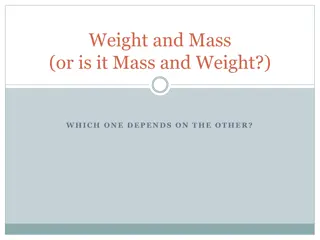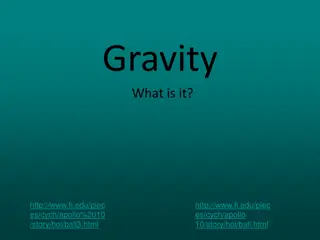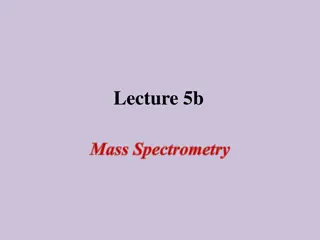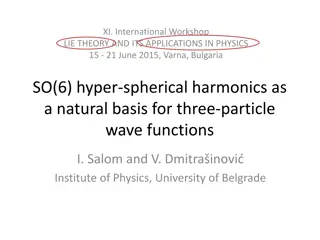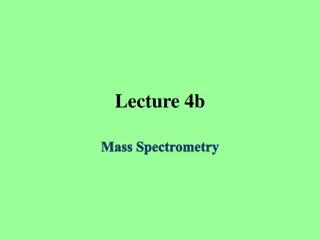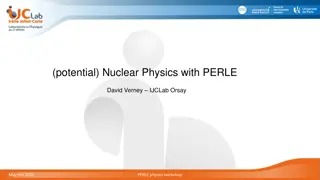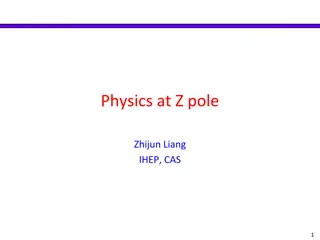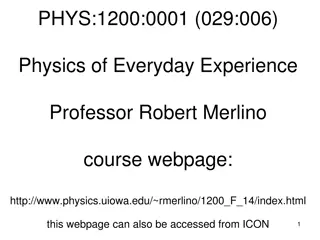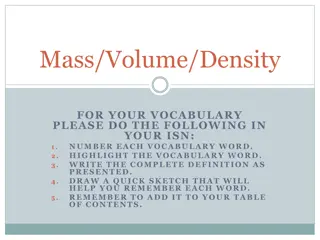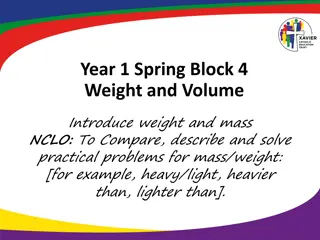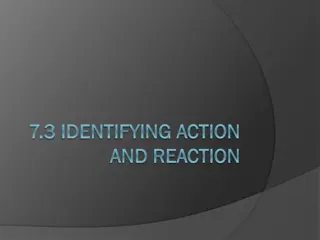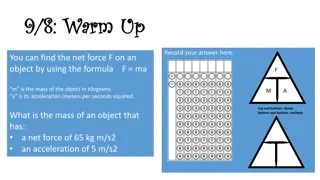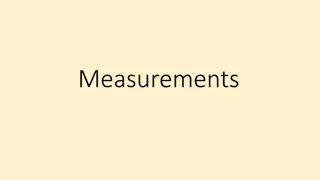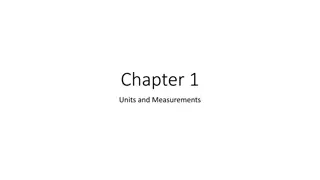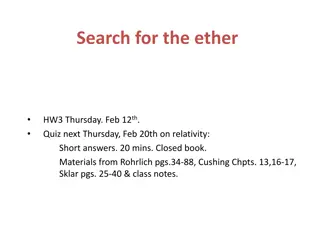Understanding Center of Mass in Physics
Exploring the concept of Center of Mass, this content delves into topics such as calculations, real-life examples, and scenarios involving the distribution of mass in different objects. From the mass of the Earth to practical applications in physics, the importance of determining the center of mass is highlighted through various images and explanations.
Download Presentation

Please find below an Image/Link to download the presentation.
The content on the website is provided AS IS for your information and personal use only. It may not be sold, licensed, or shared on other websites without obtaining consent from the author. Download presentation by click this link. If you encounter any issues during the download, it is possible that the publisher has removed the file from their server.
E N D
Presentation Transcript
Chapter 9 Center of Mass
Lecture 1 Center of Mass
Mass of the earth = 5.9742 1024kg Center of mass (com) Mass of the earth is concentrated at the center of the earth.
Center of Mass Motion m2 m1 Center of Mass = Total Mass of the system = m1+m2 Centre of mass is the equivalent point mass of the system
Center of Mass calculation from origin m1 m2 X-axis 0 x1 xcom + = + ( ) xcom m m x m x m x2 1 2 1 1 2 2 + x m x m = 1 1 2 2 xcom + m m 2 2
Center of Mass calculation If origin is not given you can choose as per your convenience d Choose the origin such that the unknown quantity will not show up in the equation m2 m1 + = + ( ) . 0 . xcom m m m = d m xcom x2 1 ( 2 1 2 xcom x1 + ) . xcom m m d m 1 2 2 Origin Origin Origin + = + ( )( ) ( ). . 0 xcom m m d m m + = + 0 .( ) ( ) m m x m x m 1 2 m 1 2 1 2 1 1 2 2 + = ( ) . xcom m d m = x m x m 1 2 1 1 1 2 2
Where is the Centre of Mass? Plastic sphere You cut it Filled it with gold
Check Point-1 (a) origin; (b) 3rd quadrant; (c) on y axis below origin; (d) origin; (e) 4th quadrant; (f) origin The figure shows a uniform square plate from which four identical squares at the corners will be removed a) where is com of plate originally? b) where it is after removal of square 1 c) after removal of square 1 and 2 d) after removal of square 1 and 3 e) after removal of square 1, 2 and 3 f) All four square Answers in term of Quadrant, axes or points
Where is the Centre of Mass? 3rd Quadrant
Center of Mass calculation of three bodies m3 m2 m1 X-axis 0 x1 xcom xcom x2 x3 + + = + + ( ) xcom m m m x m x m x m 1 2 3 1 1 2 2 3 3 + + x m x m x m = 1 1 2 m 2 3 3 xcom + + m m 1 2 3
Center of Mass: three bodies m3 x3 x1 m1 y3 y1 X-axis 0 y2 x2 m2 + + = + + ( ) ( ) ycom m m m y m y m y m + + = + + ( ) xcom m m m x m x m x m 1 2 3 1 1 2 2 3 3 1 2 3 1 1 2 2 3 3 + + x m x m x m + y m y m y m = 1 1 2 m 2 3 3 xcom = 1 1 2 m 2 3 3 ycom + + m m + + m m 1 2 3 1 2 3
Center of Mass: 2-dimension m3 r3 m1 r1 X-axis 0 r2 + + r m r m r m = 1 1 2 m 2 3 3 rcom + + m2 m m 1 2 3 = + 2 com x 2 com | | com r y i + j = r x y com com com
Center of Mass: 3D m3 r3 m1 r1 X-axis 0 r r r2 + + m m r m = 1 1 2 m 2 3 3 rcom + + m m 1 2 3 m2 r k i j = + + x y z 1 1 1 1 k i j = + + r x y z k i j = + + r x y z 2 2 2 2 com com com com i j = + + r x y z k 3 3 3 3 = + + 2 com x 2 com 2 com | | com r y z
Velocity, Acceleration and force on CoM = + + + com x m x m 1 x m x m 1 2 2 n n Differentiation both sides with respect to time dx dx dx dx = + + + 1 2 com dt n m m m m 1 2 n dt dt dt = + + + com v m v m v m v m , 1 1 2 2 x x x nx n Again differentiation both sides with respect to time = + + + a m a m a m a m , 1 1 2 2 com x x x nx n = + + + F F F F , 1 2 com x x x nx
Velocity, acceleration and force on com Y-axis = + + + y m y m y m y m 1 1 2 2 com n n = + + + com v m v m v m v m , 1 1 2 2 y y y ny n = + + + a m a m a m a m , 1 1 2 2 com y y y ny n = + + + F F F F , 1 2 com y y y ny Z-axis = + + + z m z m z m z m 1 1 2 2 com n n = + + + com v m v m v m v m , 1 1 2 2 z z z nz n = + + + a m a m a m a m , 1 1 2 2 com z z z nz n = + + + F F F F , 1 2 com z z z nz
Velocity, acceleration and force on com = + + + com r m r m r m r m 1 1 2 2 n n = + + + com v m v m v m v m 1 1 2 2 n n = + + + com a m a m 1 a m a m 1 2 2 n n = + + + F F F F 1 2 com n k i j = + + 2 cm 2 cm 2 cm | | cm r x y z = + + r x y z cm cm cm cm
Check Point-2 There is no external force applied, hence the COM will not change in all three cases They will always meet at center of mass (COM)
T042:Q8: Four masses, m1 = 1.0 kg, m2 = 2.0 kg, m3 = 3.0 kg and m4 = 4.0 kg are placed at the corners of a square of side a = 1.0 m, as shown in Fig 3. The x and y coordinates of their center of mass are: (Ans: (0.5 m, 0.7 m))
Q# 9. A uniform plate is shaped as in Fig(3). Find the coordinates of the center of mass of the plate? (A1 (0,1.67) m) T102-Q8. An object consists of a uniform 4.0-kg rod of length 1.5 m which is hinged perpendicular to another uniform rod of length 1.8 m and mass 3.0 kg (see Figure 3). The longer rod has a 2.0-kg ball at one end. What are the coordinates of the center of mass of the system? Treat the ball as a point particle. A. (-0.33 m, 0.7 m)
Q10: The two pieces of uniform sheets made of the same metal are placed in the x-y plane as shown in the Figure 2. The center of mass (xcom, ycom) of this arrangement is(Ans: (-0.75, 0.75) cm) Q9. A cylindrical can is filled with two liquids of equal volume with density and 2 as shown in Figure 5. L is the length and R is the radius of the cylindrical can. The center of the circular base is at the origin of coordinate axis. Find the coordinates of center of mass (x, y) of the can filled with the two liquids, in terms of R and L. Ignore the mass of the cylindrical can and assume that the two liquids do not mix with each other. A. (0,5/12L)
Q#9: A sulfur dioxide molecule SO2 consists of a Sulfur atom (M = 32 u) located at the origin with two Oxygen atoms each of mass (m = 16 u) bound to it as in Fig 4. The angle between the two bonds is 120 . If each bond is 0.1432 nm long, what is the location of the center of mass of the molecule (x,y)? (Ans: (0.0358, 0) nm)
Q7 A 1.0 kg particle is moving with a velocity of 16 m/s along the positive x direction while a 3.0 kg particle is moving with a velocity of 4.0 m/s along the positive y direction. Find the magnitude of their center of mass velocity. (Ans 5.0 m/s ) Q10. A 2.00-kg particle has a velocity of 4.00 m/s in the positive x direction and a 3.00-kg particle has a velocity of 5.00 m/s in the positive y direction. What is the speed of their center of mass? A) 3.40 m/s
Q9 Two particles m1 and m2, 5.0-kg each, are initially at rest. External forces F1 and F2, 12 N each, are acting on these particles as shown in Fig. The acceleration of the center of mass of the two particles system is (Answer: 1.2 j m/s2 )
Momentum (p) p p d = = m m ( v v ) d dt dt d d d p p p d d d v v v = = = = = = m m m m m a a F dt dt dt dt dt dt
Linear momentum of a system = + + + ......... com v m m v m v m v , 1 1 2 2 x x x n nx = + + + ......... p p p p , 1 2 com x x x nx = + + + ........ p p p p Similarly, , 1 2 com y y y ny = + + + ........ p p p p , 1 2 com z z z nz = + + p p i p j p k , , , com x com y com z p = Mv Net momentum com dp F = Net force dt
Collision and Impulse (J) p d = F = = = dt = J p p p Fdt 0 d p F dt = = = J p p p F dt 0 x x x x x p f p p = d F dt = = = J p p p F dt 0 y y y y y i = p p F dt 0 The average value of J can also be calculated as = = p p p Fdt Impulse (J) = 0 = = av J p p F t 0 J = Area under the F and t curve If the time of collision is brief (very short) the change in momentum in called impulse
Check Point-3 a) 1, 3, 2&4 tie b) 3
Check Point-4 a) Unchanged: p = mv 0 in both situation b) Unchanged: J = p c) decreases: F = J/ t, t increases
Q9. An impulsive force Fas a function of time is shown in the Fig. as applied to an object (m = 5.0 kg) at rest. What will be its final speed? A) 2.0 m/s.
Q10. A 10.0 kg toy car is moving along the x axis. The only force Fx acting on the car is shown in Fig. 5 as a function of time (t). At time t = 0 s the car has a speed of 4.0 m/s. What is its speed at time t = 6.0 s? (Ans: 8.0 m/s ) Q9. At time t = 0, a 3.0-kg block slides along a frictionless surface with a constant speed of 5.0 m/s in the positive x-direction. A horizontal, time dependent force is applied along the positive x-direction to the block as shown in Figure 4. What is the speed of the block at t = 10 seconds? A. 19 m/s
Check Point-5 a) 0 b) positive c) j Q10. A 0.55 kg ball falls directly down onto concrete hitting it with a speed of 4.0 m/s and rebouncing directly upward with the same speed of 4.0 m/s. What is the impulse on the ball? ( j is the unit vector in the upward positive y-direction) A) (+4.4 N.s) j Q12. A 1.0-kg ball moving with a speed of 2.0 m/s perpendicular to a wall rebounds from the wall (opposite to its original direction) with a speed of 2.0 m/s .The change in the momentum of the ball is: A) 4.0 N s away from the wall
Lecture 2 Collision
Isolated system = No external force = 0 F p = 0 p t = 0 p = 0 p Initial momentum = final momentum In every collision of an isolated system the total momentum of the system remains constant (doesn t change) What will happen to com of the system? It will not change!
There are two types of collisons Elastic Collision p = 0 K = 0 Momentum conserved Kinetic Energy also conserved Inelastic Collision p = 0 K 0 Momentum conserved Kinetic Energy doesn t conserved
1D: Elastic Collision v2f v1f v2i m2 m1 m2 p = 0 + = + m v m v m v m v + = + p p p p 1 1 2 2 1 1 2 2 i i f f 1 2 1 2 i i f f K = 0 1 1 1 1 + = + KE KE KE KE + = + 2 1 2 2 2 1 2 2 m v m v m v m v 1 2 1 2 i i f f 1 2 1 2 i i f f 2 2 2 2 Solving both equations 2 2 m m m + m + m m = + = + 1 2 2 1 2 1 v v v v v v 1 1 2 2 1 2 f i i f i i + + m m m m m m m m 1 2 1 2 1 2 1 2 This is the formula for collision
1D: Elastic Collision v2f v1f m2 m1 2 2 m m m + m m m + = + = + 1 2 2 2 1 1 v v v v v v 1 1 2 2 2 1 f i i f i i + + m m m m m m m m 1 2 1 2 1 2 1 2 2 m m m + = + ( ) 2 1 1 v v v 2 m m m + 2 2 1 f i i + = + m m m m ( ) 1 2 2 m v v v 1 2 1 2 1 1 2 f i i + m m m 1 2 1 2 Don t forget the ve and +ve sign of the direction Example 1. Sphere A has mass m and is moving with velocity v. It makes a head-on elastic collision with a stationary sphere B of mass 2m. After the collision their speeds vA and vB are, respectively: A) v/3, 2v/3 Example 2 Block 1 of mass 1.00 kg is moving with an initial speed of 4.00 m/s on a frictionless horizontal surface. It makes an elastic head on collision with a stationary block 2 of mass 12.0 kg. What is the kinetic energy of block 2 after collision? A) 2.27 J
2D- Elastic Collision v1f sin 1 v2f v1f v2i 1 v1f cos 1 v1i m2 m1 v2f cos 2 m2 2 1 v2f sin 2 x p = 0 + = + + = + cos cos p p p p m v m v m v m v 1 2 1 2 1 1 2 2 1 1 1 2 2 2 ix ix fx fx i i f f y p = 0 + = + p p p p = + 0 ( sin ) m v Sin m v 1 2 1 2 iy iy fy fy 1 1 1 2 2 2 f f K = 0 1 1 1 1 + = + 2 1 2 2 2 1 2 2 + = + m v m v m v m v KE KE KE KE 1 2 1 2 i i f f 1 2 1 2 i i f f 2 2 2 2
1D: Complete Inelastic Collision p = 0 + = p p p 1 2 i i f Note: The total energy of a system (elastic or inelastic) always conserves. + = + ( ) m v m v m m v 1 1 2 2 1 2 i i But K 0 KE KE i f
2D-Inelastic Explosion v1f sin 1 When a single body breaks into two bodies v1f 1 v1f cos 1 v2f v1i m2 m1 v2f cos 2 2 M v2f sin 2 x p = 0 = + p p p = + cos cos Mv m v m v 1 2 ix fx fx 1 1 1 2 2 2 i f f y p = 0 = + p p p = + 0 ( cos ) m v Sin m v 1 2 iy fy fy 1 1 1 2 2 2 f f But KE KE K 0 i f
2D-Complete Inelastic Collision When two body combines to one body and moves together after collision v y v 1 v v x x p = 0 = + ( x v ) m v m m 1 1 1 2 p = p ix fx v y p 2 = 0 = + ( y v ) m v m m p = p 2 2 1 2 iy fy
Check Point-6 a) 0 b) No c) Negative x T102-Q10. An object is at rest at the origin. It explodes into three equal pieces. One piece moves to the west. What are the possible directions of motion of the other two pieces? Q11. A projectile has a range R. At its highest point the projectile explodes into two equal parts. One part falls vertically down. How far from the firing point will the other part land? a. north, south-east b. north, north-east c. south, south-east d. south, south-west e. east, north A) 3R/2
Check Point-7 c) 6 Kg.m/s a) 10 Kg.m/s b) 14 Kg.m/s Q10. A 3.0-kg and a 2.0-kg carts approach each other on a horizontal air track. They collide and stick together. After the collision their total kinetic energy is 0.40 x102 J. The initial speed of their center of mass was: A) 4.0 m/s Q11. Two objects with the same mass move along the same line in opposite directions. The first object is moving with speed v to the right. The two objects collide in a perfectly inelastic collision and move with speed 0.40 v to the right, just after the collision. What was the speed of the second object before the collision? A) 0.20 v
Check Point-8 a) 4 Kg.m/s b) 8 Kg.m/s c) 3 J Figure9- 20
Check Point 9 target a) 2 Kg.m/s b) 3 Kg.m/s Figure9- 23
Examples Elastic Q12. An object of mass m1 = 2.0 kg is moving with a velocity of 4.0 m/s along the x-axis on a frictionless horizontal surface and collides with another object of mass m2 = 3.0 kg initially at rest. After collision both masses continue to move on the frictionless surface as shown in Figure 7. If m1 moves with a velocity of 3.0 m/s at an angle of 30o with respect to the x- axis, what will be the magnitude of the x- and y-components of the momentum of mass m2 (in kg m/s)? A) 2.8 and 3.0 Find the energy lost in the system.











